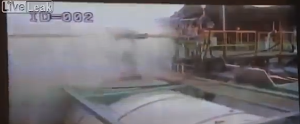26 December | RESEARCH PAPERS A | admin
Hydrofluoric Acid Leak – Hube Global Chemical Plant-South Korea.
See also ⇓
White Island New Zealand – Volcanic Gases
The initial government response to this fluoride
accident, including possible mistakes by
firefighters, and a sluggish evacuation
of nearby residents, was
sharply criticized in
the Korean media.
⇓ 7 October 2012 ⇓
Fluoride Accident South Korea

↓ This Video runs for 65 seconds ↓
→ Hydrogen Fluoride kills 5 ←
↑ WARNING, DISTURBING SHORT VIDEO ↑
.
An estimated 8 tons of HF was released.
5 people including the 2 workers perished,
18 responders, workers, reporter wound-up
in the hospital, almost 3000 villagers from
two villages downwind of the facility
were treated for irritation, exposure.
Five workers were killed and 18 others were injured in the blast at chemical maker Hube Global at the Gumi National Industrial Complex in the industrial city, about 200 kilometers southeast of Seoul. The gas leak has cost factories in the industrial complex about 17.7 billion won (US$15.9 million) in lost production, officials said. Hundreds of angry villagers in Gumi who suffered after the massive gas leak moved to a safer region with some residents reporting blood in their saliva. About 110 elderly people in Bongsan-ri village evacuated to a facility about 10 kilometers away.
.
.
More than six weeks after eight tonnes of hydrofluoric acid was accidentally released at a chemical plant in South Korea, many of the thousands of local residents who fled the area at the time have reportedly not yet returned to their homes despite assurances from authorities that the area is now safe.
The highly toxic hydrofluoric acid was released on 27 September at the Hube Global chemical plant in Gumi, about 200km from Seoul. The leak killed five workers at the plant and severely injured at least 18 others, including workers and emergency personnel. The plant is reportedly still idle after the accident with no date yet set for resuming operations.
Hydrofluoric acid is used to produce chemical precursors for the pharmaceutical industry and has other industrial applications. Highly corrosive and an acute poison, exposure can cause death and serious damage to the skin, lungs, heart, bones and nervous system.
Initial press reports at the time of the accident said more than 3000 people in villages and farms downwind of the accident inhaled fumes and required emergency treatment for health complaints, including nausea, chest pain, rashes and sore eyes. The accident also contaminated crops and sickened livestock. Around 80 other firms in the area were affected, with damages estimated at more than $20 million (£12.5 million).
The initial government response to the accident, including possible mistakes by firefighters, and a sluggish evacuation of nearby residents, was sharply criticized in the Korean media.
The government later acknowledged the severity of the incident on 8 October by designating the area around the plant a ‘special disaster zone’. Since then, additional information about the aftermath of the accident has slowed to a trickle.
.
Afraid to return home
A recent local news report says that government officials have declared that hydrofluoric acid concentrations in the air, water and soil in the affected area have dropped to levels that are no longer harmful. But the report adds that most residents are still afraid to return to their homes.
Vladimir Sakharov, director of the environmental emergencies preparedness programme at Geneva-based Green Cross International, tells Chemistry World that it is possible that hydrofluoric acid concentrations are now below dangerous levels. “If the spill was treated with neutralizing substances, normally, the situation should be under control after more than a month,” he says.
Sakharov adds: “Depending on the specifics of the response operations and local conditions, soil may become polluted by fluorides, which are strongly retained by soil components. Then, fluorides may accumulate in plants. To what extent soil is polluted by fluorides and whether it is safe to resume agricultural activities, could be determined by chemical and Eco toxicological analyses and tests.”
The commercial area in Gumi where the accident occurred was originally developed with the goal of attracting high-tech firms. But when high-tech demand failed to materialize, zoning regulations were eased to allow other industries in. In 2008, Hube Global, a South Korean-Chinese joint venture headquartered in Seoul, opened the ill-fated plant to supply raw materials to the electronics, chemicals, cosmetics, pharmaceuticals and biotech sectors.
.
Human error:
Police investigating the accident said that the hydrofluoric acid spill may have been caused by human error as two workers were unloading the chemical from a delivery tanker. A closed circuit security video camera recorded the two workers on top of the tanker, both without protective gear. They were connecting an air hose to a valve in the tanker in order to force the chemical out under high pressure. The video shows white vapour erupting at high pressure from the tanker, engulfing the workers.
Police have said the workers were trying to save time and did not follow proper safety procedures. Prosecutors plan to indict three Hube Global executives.
Firefighters who initially responded to the Hube Global accident were not apparently fully briefed on the risks of hydrofluoric acid, according to some reports. The first to arrive on the scene wore typical firefighting garments and masks – inadequate protection against hydrofluoric acid fumes. Firefighters also spread the hydrofluoric acid further by spraying water on it. At the time of the accident, neither the Gumi City Government nor the Hube Global Plant had supplies of slaked lime, an agent used to neutralize the acid.
Slaked lime was not deployed at the accident scene until the day after the leak.
“I am sure that RoK (Republic of Korea) specialists and scientists know what and how to respond from now on in,” Sakharov says.
“I would urge openness and transparency from RoK authorities, so this could benefit the entire international community.
.
Lessons from this environmental emergency would be extremely valuable for all countries: what exactly happened, what was done, what went well and what did not work, positive and negative results, achievements and shortcomings, how to prevent such accidents and be better prepared in the future?”
→ MORE ←





